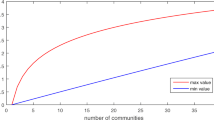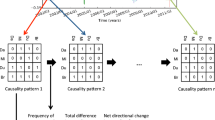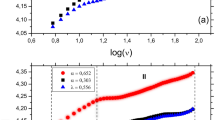Abstract
Time series analysis has proven to be a powerful method to characterize several phenomena in biology, neuroscience and economics, and to understand some of their underlying dynamical features. Several methods have been proposed for the analysis of multivariate time series, yet most of them neglect the effect of non-pairwise interactions on the emerging dynamics. Here, we propose a framework to characterize the temporal evolution of higher-order dependencies within multivariate time series. Using network analysis and topology, we show that our framework robustly differentiates various spatiotemporal regimes of coupled chaotic maps. This includes chaotic dynamical phases and various types of synchronization. Hence, using the higher-order co-fluctuation patterns in simulated dynamical processes as a guide, we highlight and quantify signatures of higher-order patterns in data from brain functional activity, financial markets and epidemics. Overall, our approach sheds light on the higher-order organization of multivariate time series, allowing a better characterization of dynamical group dependencies inherent to real-world data.
This is a preview of subscription content, access via your institution
Access options
Access Nature and 54 other Nature Portfolio journals
Get Nature+, our best-value online-access subscription
$29.99 / 30 days
cancel any time
Subscribe to this journal
Receive 12 print issues and online access
$209.00 per year
only $17.42 per issue
Buy this article
- Purchase on Springer Link
- Instant access to full article PDF
Prices may be subject to local taxes which are calculated during checkout





Similar content being viewed by others
Data availability
All data needed to evaluate the conclusions of this paper are available on Zenodo (10.5281/zenodo.7210075).
Code availability
The code used in this work is available at: https://github.com/andresantoro/RHOSTS as well as a maintained version on E.A.’s GitHub page (https://github.com/eamico).
Change history
25 January 2023
A Correction to this paper has been published: https://doi.org/10.1038/s41567-023-01963-2
References
Boccaletti, S., Latora, V., Moreno, Y., Chavez, M. & Hwang, D.-U. Complex networks: structure and dynamics. Phys. Rep. 424, 175–308 (2006).
Pastor-Satorras, R., Castellano, C., Van Mieghem, P. & Vespignani, A. Epidemic processes in complex networks. Rev. Mod. Phys. 87, 925–979 (2015).
Arenas, A., Díaz-Guilera, A., Kurths, J., Moreno, Y. & Zhou, C. Synchronization in complex networks. Phy. Rep. 469, 93–153 (2008).
Barrat, A., Barthelemy, M. & Vespignani, A. Dynamical Processes on Complex Networks (Cambridge Univ. Press, 2008).
Watts, D. J. & Dodds, P. S. Influentials, networks, and public opinion formation. J. Consum. Res. 34, 441–458 (2007).
Latora, V., Nicosia, V. & Russo, G. Complex Networks: Principles, Methods and Applications (Cambridge Univ. Press, 2017).
Benson, A. R., Gleich, D. F. & Leskovec, J. Higher-order organization of complex networks. Science 353, 163–166 (2016).
Petri, G. et al. Homological scaffolds of brain functional networks. J. R. Soc. Interface 10, 186–198 (2014).
Giusti, C., Pastalkova, E., Curto, C. & Itskov, V. Clique topology reveals intrinsic geometric structure in neural correlations. Proc. Natl Acad. Sci. USA 112, 13455–13460 (2015).
Sizemore, A. E. et al. Cliques and cavities in the human connectome. J. Comput. Neurosci. 44, 115–145 (2018).
Grilli, J., Barabás, G., Michalska-Smith, M. J. & Allesina, S. Higher-order interactions stabilize dynamics in competitive network models. Nature 548, 210–213 (2017).
Sanchez-Gorostiaga, A., Bajić, D., Osborne, M. L., Poyatos, J. F. & Sanchez, A. High-order interactions distort the functional landscape of microbial consortia. PLOS Biol. 17, 3000550 (2019).
Battiston, F. et al. Networks beyond pairwise interactions: structure and dynamics. Phys. Rep. 874, 1–92 (2020).
Torres, L., Blevins, A. S., Bassett, D. & Eliassi-Rad, T. The why, how, and when of representations for complex systems. SIAM Rev. 63, 435–485 (2021).
Battiston, F. et al. The physics of higher-order interactions in complex systems. Nat. Phys. 17, 1093–1098 (2021).
Battiston, F. & Petri, G. Higher-Order Systems (Springer, 2022).
Millán, A. P., Torres, J. J. & Bianconi, G. Synchronization in network geometries with finite spectral dimension. Phys. Rev. E 99, 022307 (2019).
Schaub, M. T., Benson, A. R., Horn, P., Lippner, G. & Jadbabaie, A. Random walks on simplicial complexes and the normalized Hodge 1-Laplacian. SIAM Rev. 62, 353–391 (2020).
Carletti, T., Battiston, F., Cencetti, G. & Fanelli, D. Random walks on hypergraphs. Phys. Rev. E 101, 022308 (2020).
Iacopini, I., Petri, G., Barrat, A. & Latora, V. Simplicial models of social contagion. Nat. Commun. 10, 1–9 (2019).
de Arruda, G. F., Petri, G. & Moreno, Y. Social contagion models on hypergraphs. Phys. Rev. Res. 2, 023032 (2020).
Sahasrabuddhe, R., Neuhäuser, L. & Lambiotte, R. Modelling non-linear consensus dynamics on hypergraphs. J. Phys. Complex. 2, 025006 (2021).
Alvarez-Rodriguez, U. et al. Evolutionary dynamics of higher-order interactions in social networks. Nat. Hum. Behav. 5, 586–595 (2021).
Deco, G., Jirsa, V. K. & McIntosh, A. R. Emerging concepts for the dynamical organization of resting-state activity in the brain. Nat. Rev. Neurosci. 12, 43–56 (2011).
Avena-Koenigsberger, A., Misic, B. & Sporns, O. Communication dynamics in complex brain networks. Nat. Rev. Neurosci. 19, 17–33 (2018).
Mantegna, R. N. & Stanley, H. E. Introduction to Econophysics: Correlations and Complexity in Finance (Cambridge Univ. Press, 1999).
Peron, T. K. D. & Rodrigues, F. A. Collective behavior in financial markets. Europhys. Lett. 96, 48004 (2011).
Brugere, I., Gallagher, B. & Berger-Wolf, T. Y. Network structure inference, a survey: motivations, methods, and applications. ACM Comput. Surv. 51, 24–12439 (2018).
Young, J. G., Petri, G. & Peixoto, T. P. Hypergraph reconstruction from network data. Commun. Phys. 4, 1–11 (2021).
Musciotto, F., Battiston, F. & Mantegna, R. N. Detecting informative higher-order interactions in statistically validated hypergraphs. Commun. Phys. 4, 1–9 (2021).
Wang, H., Ma, C., Chen, H.-S., Lai, Y.-C. & Zhang, H.-F. Full reconstruction of simplicial complexes from binary contagion and ising data. Nat. Commun. 13, 3043 (2022).
Lizotte, S., Young, J.-G., Allard, A. Hypergraph reconstruction from noisy pairwise observations. Preprint at https://arxiv.org/abs/2208.06503 (2022).
Rosas, F. E. et al. Disentangling high-order mechanisms and high-order behaviours in complex systems. Nat. Phys. 18, 476–477 (2022).
Faes, L. et al. A New Framework for the Time- and Frequency-Domain Assessment of High-Order Interactions in Networks of Random Processes. In IEEE Transactions on Signal Processing 1–12 (IEEE, 2022).
Rosas, F. E., Mediano, P. A. M., Gastpar, M. & Jensen, H. J. Quantifying high-order interdependencies via multivariate extensions of the mutual information. Phys. Rev. E 100, 32305 (2019).
Stramaglia, S., Scagliarini, T., Daniels, B. C. & Marinazzo, D. Quantifying dynamical high-order interdependencies from the O-information: an application to neural spiking dynamics. Front. Physiol. 11, 1–11 (2021).
MacMahon, M. & Garlaschelli, D. Community detection for correlation matrices. Phys. Rev. X 5, 021006 (2015).
Tagliazucchi, E., Balenzuela, P., Fraiman, D. & Chialvo, D. Criticality in large-scale brain fMRI dynamics unveiled by a novel point process analysis. Front. Physiol. 3, 15 (2012).
Liu, X. & Duyn, J. H. Time-varying functional network information extracted from brief instances of spontaneous brain activity. Proc. Natl Acad. Sci. USA 110, 4392–4397 (2013).
Faskowitz, J., Esfahlani, F. Z., Jo, Y., Sporns, O. & Betzel, R. F. Edge-centric functional network representations of human cerebral cortex reveal overlapping system-level architecture. Nat. Neurosci. 23, 1644–1654 (2020).
Esfahlani, F. Z. et al. High-amplitude cofluctuations in cortical activity drive functional connectivity. Proc. Natl Acad. Sci. USA 117, 28393–28401 (2020).
Van De Ville, D., Farouj, Y., Preti, M. G., Liégeois, R. & Amico, E. When makes you unique: temporality of the human brain fingerprint. Sci. Adv. 7, 0751 (2021).
Petri, G., Scolamiero, M., Donato, I. & Vaccarino, F. Topological strata of weighted complex networks. PLoS ONE 8, e66506 (2013).
Zomorodian, A. & Carlsson, G. Computing persistent homology. Discrete Comput. Geom. 33, 249–274 (2005).
Ghrist, R. Barcodes: the persistent topology of data. Bull. Am. Math. Soc. 45, 61–75 (2008).
Carrière, M., Cuturi, M., Oudot, S. Sliced Wasserstein kernel for persistence diagrams. In Proceedings of the 34th International Conference on Machine Learning 70, 664–673. Proceedings of Machine Learning Research (PMLR, 2017).
Kaneko, K. Overview of coupled map lattices. Chaos 2, 279–282 (1992).
Kaneko, K. Pattern dynamics in spatiotemporal chaos. Physica D 34, 1–41 (1989).
Lacasa, L., Nicosia, V. & Latora, V. Network structure of multivariate time series. Sci. Rep. 5, 1–9 (2015).
Shrout, P. E. & Fleiss, J. L. Intraclass correlations: uses in assessing rater reliability. Psychol. Bull. 86, 420–428 (1979).
Gatica, M. et al. High-order interdependencies in the aging brain. Brain Connect. 11, 734–744 (2021).
Van Essen, D. C. et al. The WU-Minn Human Connectome Project: an overview. NeuroImage 80, 62–79 (2013).
Scarpino, S.V. & Petri, G. On the predictability of infectious disease outbreaks. Nat. Commun. 10, 1–8 (2019).
Schaefer, A. et al. Local–global parcellation of the human cerebral cortex from intrinsic functional connectivity MRI. Cereb. Cortex 28, 3095–3114 (2018).
Glasser, M. F. et al. The minimal preprocessing pipelines for the Human Connectome Project. NeuroImage 80, 105–124 (2013).
Deco, G. & Kringelbach, M. L. Turbulent-like dynamics in the human brain. Cell Rep. 33, 108471 (2020).
Deco, G., Kringelbach, M. L., Jirsa, V. K. & Ritter, P. The dynamics of resting fluctuations in the brain: metastability and its dynamical cortical core. Sci. Rep. 7, 3095 (2017).
Chialvo, D. R. Emergent complex neural dynamics. Nat. Phys. 6, 744–750 (2010).
Smith, S. M. et al. Correspondence of the brain’s functional architecture during activation and rest. Proc. Natl Acad. Sci. USA 106, 13040–13045 (2009).
Yeo, B. T. et al. The organization of the human cerebral cortex estimated by intrinsic functional connectivity. J. Neurophysiol. 106, 1125–1165 (2011).
Raichle, M. E. et al. A default mode of brain function. Proc. Natl Acad. Sci. USA 98, 676–682 (2001).
Perl, Y.S., Escrichs, A., Tagliazucchi, E., Kringelbach, M.L., Deco, G. On the edge of criticality: strength-dependent perturbation unveils delicate balance between fluctuation and oscillation in brain dynamics. Preprint at bioRxiv https://doi.org/10.1101/2021.09.23.461520 (2022).
Deco, G. et al. Rare long-range cortical connections enhance human information processing. Curr. Biol. 31, 4436–44485 (2021).
Amico, E., Arenas, A. & Goñi, J. Centralized and distributed cognitive task processing in the human connectome. Netw. Neurosci. 3, 455–474 (2019).
Kutner, R. et al. Econophysics and sociophysics: their milestones & challenges. Physica A 516, 240–253 (2019).
Musciotto, F., Pillo, J. & Mantegna, R. N. High-frequency trading and networked markets. Proc. Natl Acad. Sci. USA 118, 2015573118 (2021).
Musmeci, N., Nicosia, V., Aste, T., Di Matteo, T. & Latora, V. The multiplex dependency structure of financial markets. Complexity 2017, 9586064 (2017).
Squartini, T., van Lelyveld, I. & Garlaschelli, D. Early-warning signals of topological collapse in interbank networks. Sci. Rep. 3, 3357 (2013).
Wei, W. W. Time Series Analysis (Addison Wesley, 2005).
Bullmore, E. & Sporns, O. Complex brain networks: graph theoretical analysis of structural and functional systems. Nat. Rev. Neurosci. 10, 186–198 (2009).
Sporns, O. Networks of the Brain (MIT Press, 2010).
Wei, W. W. Multivariate Time Series Analysis and Applications (Wiley, 2019).
Hatcher, A. Algebraic Topology (Cambridge Univ. Press, 2005).
Wasserman, L. Topological data analysis. Annu. Rev. Stat. Appl. 5, 501–532 (2018).
Lum, P. Y. et al. Extracting insights from the shape of complex data using topology. Sci. Rep. 3, 1236 (2013).
Nicolau, M., Levine, A. J. & Carlsson, G. Topology based data analysis identifies a subgroup of breast cancers with a unique mutational profile and excellent survival. Proc. Natl Acad. Sci. USA 108, 7265–7270 (2011).
Saggar, M. et al. Towards a new approach to reveal dynamical organization of the brain using topological data analysis. Nat. Commun. 9, 1399 (2018).
Saggar, M., Shine, J. M., Liégeois, R., Dosenbach, N. U. F. & Fair, D. Precision dynamical mapping using topological data analysis reveals a hub-like transition state at rest. Nat. Commun. 13, 4791 (2022).
Edelsbrunner, H., Letscher, D., Zomorodian, A. Topological persistence and simplification. In Proc. of 41st Annual Symposium on Foundations of Computer Science 454–463 (2000).
Ghrist, R. Barcodes: the persistent topology of data. Bull. Am. Math. Soc. 45, 61–75 (2008).
Carlsson, G., Ishkhanov, T., de Silva, V. & Zomorodian, A. On the local behavior of spaces of natural images. Int. J. Comput. Vis. 76, 1–12 (2008).
Lee, H., Chung, M.K., Kang, H., Kim, B.-N., Lee, D.S.: Discriminative persistent homology of brain networks. In Proc. of 2011 IEEE International Symposium on Biomedical Imaging: from Nano to Macro 841–844 (IEEE, 2011).
Carstens, C. J. & Horadam, K. J. Persistent homology of collaboration networks. Math. Probl. Eng. 2013, 815035 (2013).
Horak, D., Maletić, S. & Rajković, M. Persistent homology of complex networks. J. Stat. Mech. Theory Exp. 2009, 03034 (2009).
Barrat, A., Barthelemy, M., Pastor-Satorras, R. & Vespignani, A. The architecture of complex weighted networks. Proc. Natl Acad. Sci. USA 101, 3747–3752 (2004).
Barabási, A.-L. Network Science (Cambridge Univ. Press, 2016).
Newman, M. Networks (Oxford Univ. Press, Oxford, 2018).
Aroussi, R., et al. Yahoo! Finance market data downloader. GitHub https://github.com/ranaroussi/yfinance (2022).
van Panhuis, W. G. et al. Contagious diseases in the United States from 1888 to the present. N. Engl. J. Med. 369, 2152–2158 (2013).
Van Essen, D. C. et al. The Human Connectome Project: a data acquisition perspective. NeuroImage 62, 2222–2231 (2012).
Smith, S. M. et al. Resting-state fMRI in the Human Connectome Project. NeuroImage 80, 144–168 (2013).
Karahanoğlu, F. I. & Van De Ville, D. Transient brain activity disentangles fMRI resting-state dynamics in terms of spatially and temporally overlapping networks. Nat. Commun. 6, 7751 (2015).
Preti, M. G., Bolton, T. A. & Van De Ville, D. The dynamic functional connectome: state-of-the-art and perspectives. NeuroImage 160, 41–54 (2017).
Liu, X., Zhang, N., Chang, C. & Duyn, J. H. Co-activation patterns in resting-state fMRI signals. NeuroImage 180, 485–494 (2018).
Acknowledgements
We thank L. Lacasa and J. Goñi for feedback on an earlier version of the manuscript. Data were provided (in part) by the HCP, the WU-Minn Consortium (principal investigators D. V. Essen and K. Ugurbil; 1U54MH091657) funded by the 16 NIH Institutes and Centers that support the NIH Blueprint for Neuroscience Research and by the McDonnell Center for Systems Neuroscience at Washington University. E.A. acknowledges financial support from the SNSF Ambizione project ‘Fingerprinting the brain: network science to extract features of cognition, behaviour and dysfunction’ (grant no. PZ00P2_185716). A.S. and E.A. acknowledge support from the SNSF COST project ‘Mapping the higher-order dynamics of neurodegeneration in human brain networks’ (grant no. IZCOZ0_198144). The funders had no role in study design, data collection and analysis, decision to publish, or preparation of the manuscript.
Author information
Authors and Affiliations
Contributions
A.S., F.B., G.P. and E.A. conceptualized the study. A.S. performed the numerical analysis. A.S., F.B., G.P. and E.A. wrote the paper.
Corresponding author
Ethics declarations
Competing interests
The authors declare no competing interests.
Peer review
Peer review information
Nature Physics thanks Giulio Cimini, Bratislav Misic and the other, anonymous, reviewer(s) for their contribution to the peer review of this work
Additional information
Publisher’s note Springer Nature remains neutral with regard to jurisdictional claims in published maps and institutional affiliations.
Supplementary information
Supplementary Information
Supplementary Figs. 1–17, discussion and Tables 1 and 2.
Rights and permissions
Springer Nature or its licensor (e.g. a society or other partner) holds exclusive rights to this article under a publishing agreement with the author(s) or other rightsholder(s); author self-archiving of the accepted manuscript version of this article is solely governed by the terms of such publishing agreement and applicable law.
About this article
Cite this article
Santoro, A., Battiston, F., Petri, G. et al. Higher-order organization of multivariate time series. Nat. Phys. 19, 221–229 (2023). https://doi.org/10.1038/s41567-022-01852-0
Received:
Accepted:
Published:
Issue Date:
DOI: https://doi.org/10.1038/s41567-022-01852-0
This article is cited by
-
Multivariate information theory uncovers synergistic subsystems of the human cerebral cortex
Communications Biology (2023)



